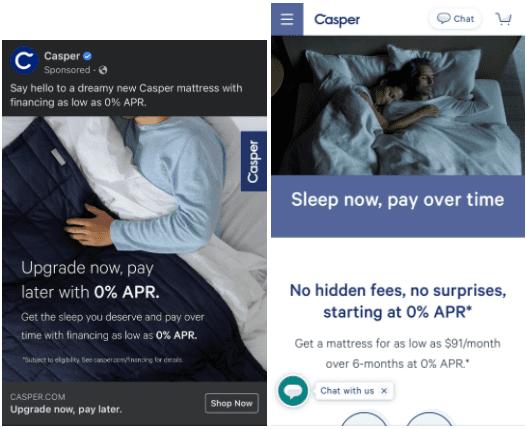Personalized ads perform better. These are facts. According to a stats round-up in Forbes:
- Marketers report personalization efforts can boost revenue by up to 15%
- Personalization can reduce customer acquisition costs by up to 50%
- Personalization can increase marketing spend efficiency by up to 30%
This isn’t news to you. Which is why your paid advertising strategy most likely includes some level of audience segmentation and targeting. So you can make sure your ad will resonate; so you can stand out from the noise and get the ever-elusive click.
But after all that careful planning and targeting, most companies are still sending people to generic landing pages (or worse — their homepage). They’re failing to make the entire experience relevant. And people are bouncing because of it.
In this post, we cover 3 tactics to test to make sure your landing pages are just as relevant and resonant as your ads — so you can convert more of your paid visitors.

Before we get into the tactics, a quick note: Stop sending paid traffic to your website homepage. Your homepage is designed to speak to the entirety of your target audience. So, by nature, it is your least personalized page. If you have the resources, you should always try to create unique landing pages for your paid campaigns.
If you’re already creating custom landing pages for your ad campaigns, well done. You’re ahead of the curve. Next step is to start testing on those landing pages.
Landing pages present a perfect opportunity to experiment with your general value proposition. Testing on your landing pages will result in a better experience for people who land on that page by nature of iteration. But these tests also often reveal insights about your most valuable audience segments that you can apply across your general marketing site, making them super valuable.
Just make sure you’ve got a strategy behind your landing page tests: Who’s the target audience? What evidence is informing this test idea? What’s the test hypothesis? A strategic approach will help you make sure your tests have the greatest impact, both in terms of ROI and learning.
On that note, here are 3 tactics to test to create more personalized, higher-converting landing pages…
Tactic #1: Matching
Make your landing page look and sound like your ad.
Matching is exactly what it sounds like. Simply matching the copy and visual design from your paid ad to your landing page lets visitors know they’re in the right place and that this shopping experience is for them. It can make a huge difference.
You can test matching your ad headline exactly, or you can test responding to your ad headline with your landing page headline. You can test adding relevant bread crumbs to remind your visitor they’re in the right place by reminding them where they came from. The key is to help your visitor maintain information scent.

Left: A Facebook ad for Casper emphasizing their flexible financing plan (possibly for a target segment that cares deeply about price). Right: The landing page you’re taken to when you click “Shop Now” which mirrors the theme of get what you want now, pay over time with 0% APR. There are other things Casper might test, like using the same image for the ad and landing page, but they’re definitely doing copy work to maintain information scent.
Tactic #2: Compliance Gaining
Test persuasion techniques with your different audience segments.
Marketers know the power of persuasion techniques. We use them all the time in our ads, copywriting, email campaigns, etc. Your paid campaigns and landing pages are a perfect place to test out different compliance gaining techniques to see what resonates with your different audience segments.
For example, you might build a variation of a landing page that uses the “disrupt-then-reframe” technique, which theorizes that a person will be more likely to take a desired action “if the initial request or pitch is confusing” and “the pitch is immediately followed by a reframing or a reason to comply with the request.”
 Apple often uses slightly disruptive headlines to market its products. The play on words and capitalization is somewhat confusing but is immediately followed by clear product details.
Apple often uses slightly disruptive headlines to market its products. The play on words and capitalization is somewhat confusing but is immediately followed by clear product details.
Note: Compliance gaining techniques can be highly effective but they can also hit your audience in entirely the wrong way. Different techniques will work for different people depending on their personality, emotional state, and context (this is where psychographic data comes in handy). So make sure to test these techniques before you double down.
Tactic #3: Bundling
Great for retargeting ads and returning visitors.
If you’re emphasizing a particular product to a particular audience in your ads, you should test surfacing other relevant products on your landing page that might speak to those visitors. This is a great technique to try with a retargeting campaign because you’ll likely already have data on these visitors and can make smarter recommendations.
This is where a testing platform like AB Tasty — which uses artificial intelligence to find the best combination of variables — can come in extremely handy.
Let’s say you’re a lifestyle brand promoting a new deodorant scent to people who visited your site in the last month. On the landing page, you want to test highlighting other products in that scent, like body wash and lotion. AB Tasty will help you test a combination of products, images, copy, etc. to find the combination that performs best for that particular audience.
Focus on Making Your Ads and Landing Pages More Relevant
If your paid ads rely on audience segmentation, you should audit your landing pages and consider how you can provide a more relevant experience for these visitors once they arrive on your site. Consider testing the three tactics outlined in this post:
- Match the copy and visual design you use in your ads for a specific audience segment on your landing page,
- Use different compliance gaining techniques and evaluate which technique resonates with which audience segment,
- Try surfacing related products on your retargeting landing pages and track which products resonate for which audience.
Ultimately, your goal should be to provide a more relevant buying journey for your unique visitors. The more relevant the buying journey, the more likely a visitor who clicked on your ad will eventually click “buy” on your site.



